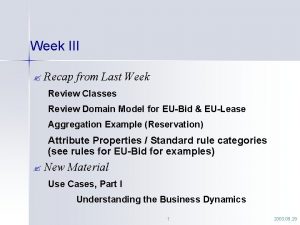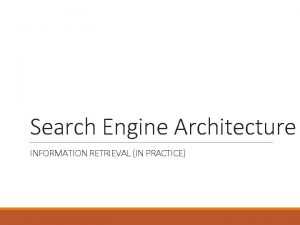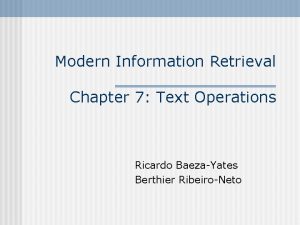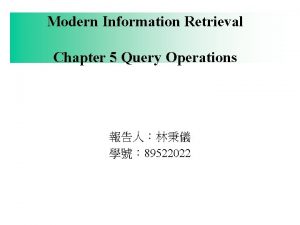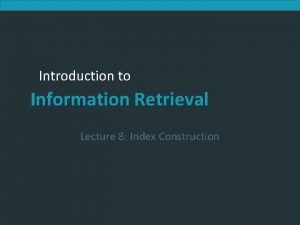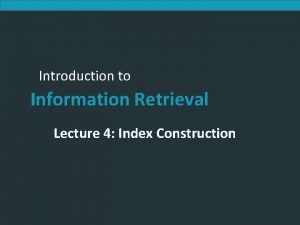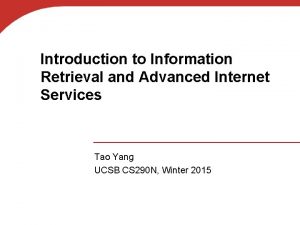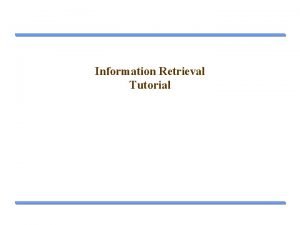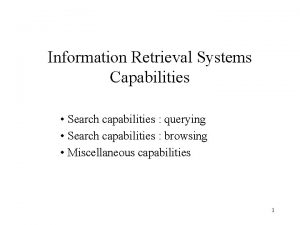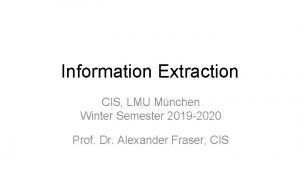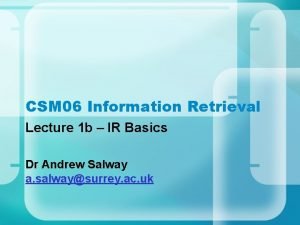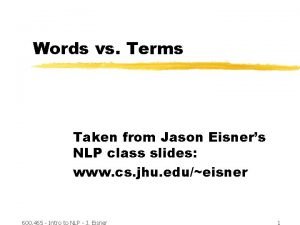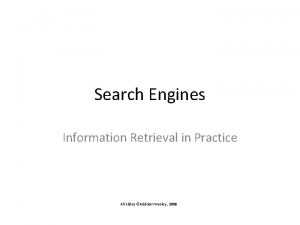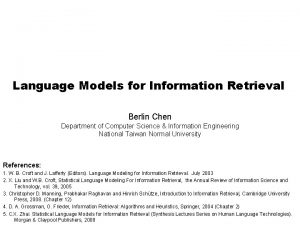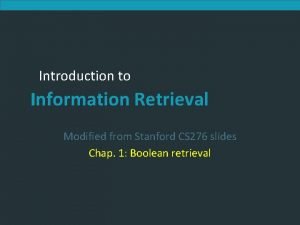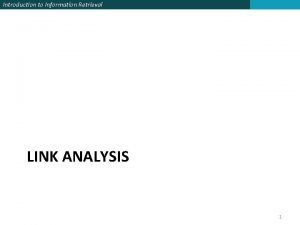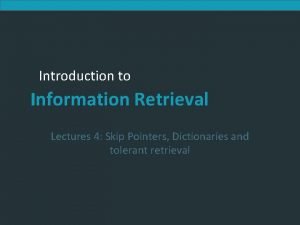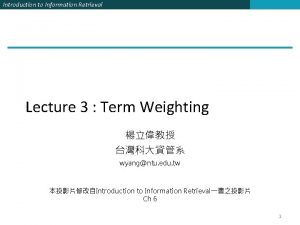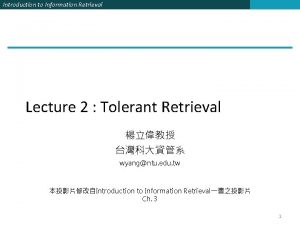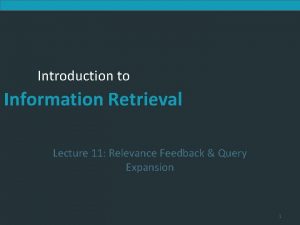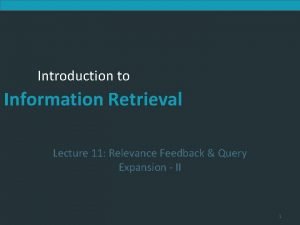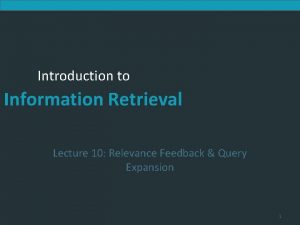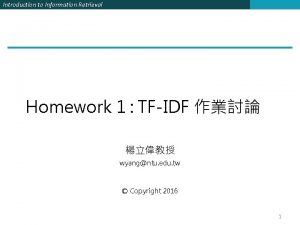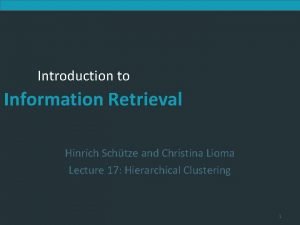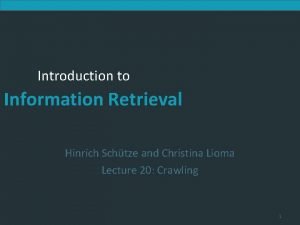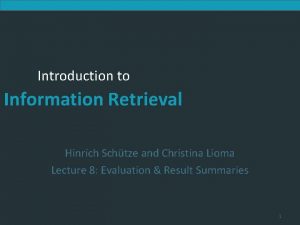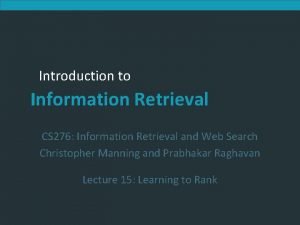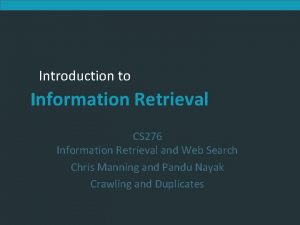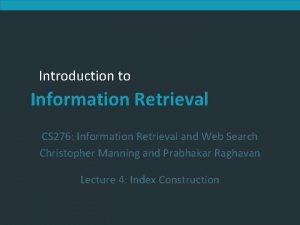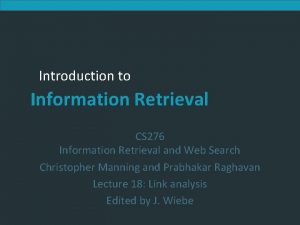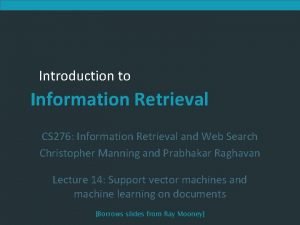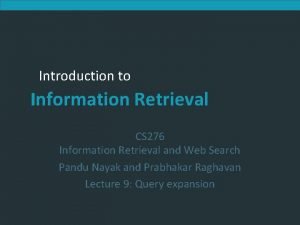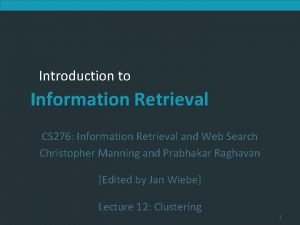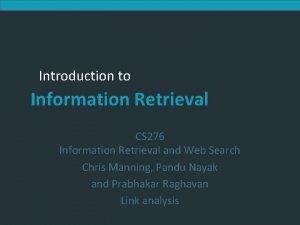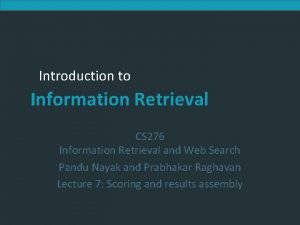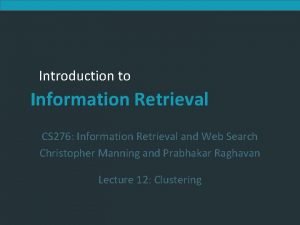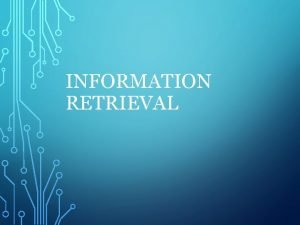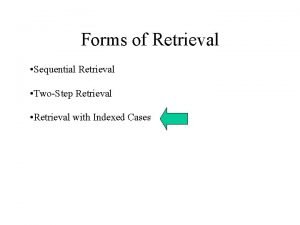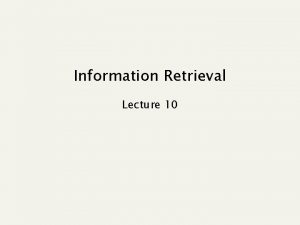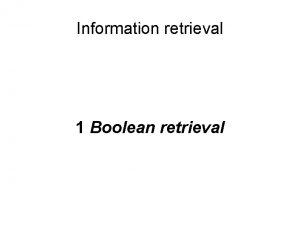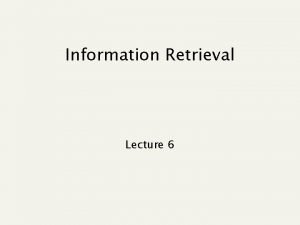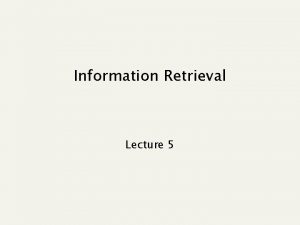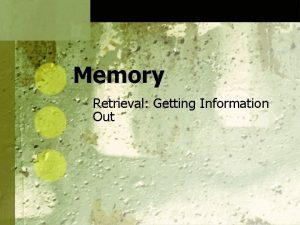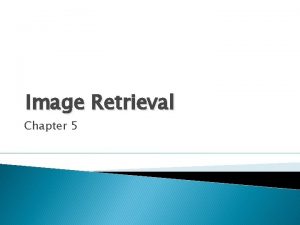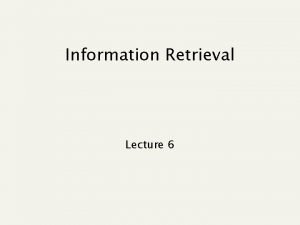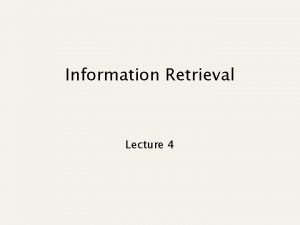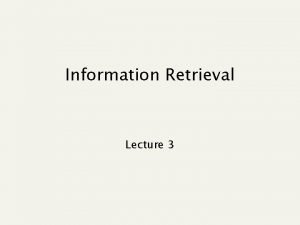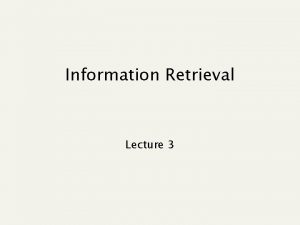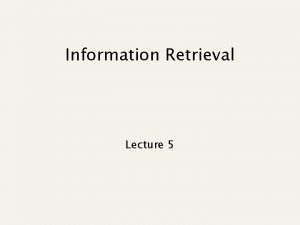Information Retrieval Lecture 7 Recap of the last











































- Slides: 43

Information Retrieval Lecture 7

Recap of the last lecture n n Vector space scoring Efficiency considerations n Nearest neighbors and approximations

This lecture n n n Evaluating a search engine Benchmarks Precision and recall

Measures for a search engine n How fast does it index n n n How fast does it search n n Number of documents/hour (Average document size) Latency as a function of index size Expressiveness of query language n Speed on complex queries

Measures for a search engine n n All of the preceding criteria are measurable: we can quantify speed/size; we can make expressiveness precise The key measure: user happiness n n What is this? Speed of response/size of index are factors But blindingly fast, useless answers won’t make a user happy Need a way of quantifying user happiness

Measuring user happiness n Issue: who is the user we are trying to make happy? n n Web engine: user finds what they want and return to the engine n n Depends on the setting Can measure rate of return users e. Commerce site: user finds what they want and make a purchase n n Is it the end-user, or the e. Commerce site, whose happiness we measure? Measure time to purchase, or fraction of searchers who become buyers?

Measuring user happiness n Enterprise (company/govt/academic): Care about “user productivity” n n How much time do my users save when looking for information? Many other criteria having to do with breadth of access, secure access … more later

Happiness: elusive to measure n n Commonest proxy: relevance of search results But how do you measure relevance? Will detail a methodology here, then examine its issues Requires 3 elements: 1. A benchmark document collection 2. A benchmark suite of queries 3. A binary assessment of either Relevant or Irrelevant for each query-doc pair

Evaluating an IR system n n Note: information need is translated into a query Relevance is assessed relative to the information need not the query

Standard relevance benchmarks n n n TREC - National Institute of Standards and Testing (NIST) has run large IR testbed for many years Reuters and other benchmark doc collections used “Retrieval tasks” specified n n sometimes as queries Human experts mark, for each query and for each doc, Relevant or Irrelevant n or at least for subset of docs that some system returned for that query

Precision and Recall n n Precision: fraction of retrieved docs that are relevant = P(relevant|retrieved) Recall: fraction of relevant docs that are retrieved = P(retrieved|relevant) Relevant Not Relevant tp fp Not Retrieved fn tn Retrieved n n Precision P = tp/(tp + fp) Recall R = tp/(tp + fn)

Why not just use accuracy? n How to build a 99. 9999% accurate search engine on a low budget…. Search for: n People doing information retrieval want to find something and have a certain tolerance for junk

Precision/Recall n n Can get high recall (but low precision) by retrieving all docs for all queries! Recall is a non-decreasing function of the number of docs retrieved n Precision usually decreases (in a good system)

Difficulties in using precision/recall n n Should average over large corpus/query ensembles Need human relevance assessments n n Assessments have to be binary n n People aren’t reliable assessors Nuanced assessments? Heavily skewed by corpus/authorship n Results may not translate from one domain to another

A combined measure: F n n Combined measure that assesses this tradeoff is F measure (weighted harmonic mean): People usually use balanced F 1 measure n n i. e. , with = 1 or = ½ Harmonic mean is conservative average n See CJ van Rijsbergen, Information Retrieval

F 1 and other averages

Ranked results n Evaluation of ranked results: n n You can return any number of results ordered by similarity By taking various numbers of documents (levels of recall), you can produce a precision- recall curve

Precision-recall curves

Interpolated precision n If you can increase precision by increasing recall, then you should get to count that…

Evaluation n There are various other measures n Precision at fixed recall n n Perhaps most appropriate for web search: all people want are good matches on the first one or two results pages 11 -point interpolated average precision n The standard measure in the TREC competitions: you take the precision at 11 levels of recall varying from 0 to 1 by tenths of the documents, using interpolation (the value for 0 is always interpolated!), and average them

Creating Test Collections for IR Evaluation

Test Corpora

From corpora to test collections n Still need n n n Test queries Relevance assessments Must be germane to docs available Best designed by domain experts Random query terms generally not a good idea Relevance assessments n n Human judges, time-consuming Are human panels perfect?

Kappa measure for judge agreement n Kappa measure n n n n Agreement among judges Designed for categorical judgments Corrects for chance agreement Kappa = [ P(A) – P(E) ] / [ 1 – P(E) ] P(A) – proportion of time coders agree P(E) – what agreement would be by chance Kappa = 0 for chance agreement, 1 for total agreement.

Kappa Measure: Example Number of docs Judge 1 Judge 2 300 Relevant 70 Nonrelevant 20 Relevant Nonrelevant 10 Nonrelevant P(A)? P(E)?

Kappa Example n P(A) = 370/400 = 0. 925 P(nonrelevant) = (10+20+70+70)/800 = 0. 2125 P(relevant) = (10+20+300)/800 = 0. 7878 P(E) = 0. 2125^2 + 0. 7878^2 = 0. 665 Kappa = (0. 925 – 0. 665)/(1 -0. 665) = 0. 776 n For >2 judges: average pairwise kappas n n

Kappa Measure n n n Kappa > 0. 8 = good agreement 0. 67 < Kappa < 0. 8 -> “tentative conclusions” (Carletta 96) Depends on purpose of study

Interjudge Agreement: TREC 3


Impact of Interjudge Agreement n n Impact on absolute performance measure can be significant (0. 32 vs 0. 39) Little impact on ranking of different systems or relative performance

Recap: Precision/Recall n Evaluation of ranked results: n n n You can return any number of ordered results By taking various numbers of documents (levels of recall), you can produce a precision- recall curve Precision: #correct&retrieved/#retrieved Recall: #correct&retrieved/#correct The truth, the whole truth, and nothing but the truth. n n Recall 1. 0 = the whole truth Precision 1. 0 = nothing but the truth.

F Measure n n n F measure is the harmonic mean of precision and recall (strictly speaking F 1) 1/F = ½ (1/P + 1/R) Use F measure if you need to optimize a single measure that balances precision and recall.

F-Measure F 1(0. 956) = max = 0. 96

Breakeven Point n n n Breakeven point is the point where precision equals recall. Alternative single measure of IR effectiveness. How do you compute it?

Area under the ROC Curve n n n True positive rate = recall = sensitivity False positive rate = fp/(tn+fp). Related to precision. fpr=0 <-> p=1 Why is the blue line “worthless”?

Precision Recall Graph vs ROC

Unit of Evaluation n n We can compute precision, recall, F, and ROC curve for different units. Possible units n n Documents (most common) Facts (used in some TREC evaluations) Entities (e. g. , car companies) May produce different results. Why?

Critique of Pure Relevance n Relevance vs Marginal Relevance n n n n A document can be redundant even if it is highly relevant Duplicates The same information from different sources Marginal relevance is a better measure of utility for the user. Using facts/entities as evaluation units more directly measures true relevance. But harder to create evaluation set See Carbonell reference

Can we avoid human judgements? n n Not really Makes experimental work hard n n n Especially on a large scale In some very specific settings, can use proxies Example below, approximate vector space retrieval

Approximate vector retrieval n n Given n document vectors and a query, find the k doc vectors closest to the query. Exact retrieval – we know of no better way than to compute cosines from the query to every doc Approximate retrieval schemes – such as cluster pruning in lecture 6 Given such an approximate retrieval scheme, how do we measure its goodness?

Approximate vector retrieval n n n Let G(q) be the “ground truth” of the actual k closest docs on query q Let A(q) be the k docs returned by approximate algorithm A on query q For precision and recall we would measure A(q) G(q) n Is this the right measure?

Alternative proposal n n n Focus instead on how A(q) compares to G(q). Goodness can be measured here in cosine proximity to q: we sum up q d over d A(q). Compare this to the sum of q d over d G(q). n n Yields a measure of the relative “goodness” of A vis-à-vis G. Thus A may be 90% “as good as” the groundtruth G, without finding 90% of the docs in G. For scored retrieval, this may be acceptable: Most web engines don’t always return the same answers for a given query.

Resources for this lecture n MG 4. 5
 Recap from last week
Recap from last week 01:640:244 lecture notes - lecture 15: plat, idah, farad
01:640:244 lecture notes - lecture 15: plat, idah, farad Algorithm for sequential search
Algorithm for sequential search Search engine architecture in information retrieval
Search engine architecture in information retrieval Information retrieval evaluation
Information retrieval evaluation Modern information retrieval
Modern information retrieval Query operations in information retrieval
Query operations in information retrieval Skip pointer information retrieval
Skip pointer information retrieval Index construction in information retrieval
Index construction in information retrieval Index construction in information retrieval
Index construction in information retrieval Which internet service is used for information retrieval
Which internet service is used for information retrieval Information retrieval tutorial
Information retrieval tutorial Wild card queries in information retrieval
Wild card queries in information retrieval Browse capabilities in information retrieval system
Browse capabilities in information retrieval system Link analysis in information retrieval
Link analysis in information retrieval Information retrieval lmu
Information retrieval lmu Defense acquisition management information retrieval
Defense acquisition management information retrieval Advantages of information retrieval system
Advantages of information retrieval system Information retrieval nlp
Information retrieval nlp Signature file structure in information retrieval system
Signature file structure in information retrieval system Information retrieval slides
Information retrieval slides Relevance information retrieval
Relevance information retrieval Information retrieval stanford
Information retrieval stanford Link analysis in information retrieval
Link analysis in information retrieval Skip pointers in information retrieval
Skip pointers in information retrieval Information retrieval
Information retrieval Information retrieval
Information retrieval Information retrieval
Information retrieval Information retrieval
Information retrieval Relevance information retrieval
Relevance information retrieval Information retrieval
Information retrieval Information retrieval
Information retrieval Url image
Url image Information retrieval
Information retrieval Cs-276
Cs-276 Information retrieval
Information retrieval Cs 276
Cs 276 Information retrieval
Information retrieval Information retrieval
Information retrieval Relevance information retrieval
Relevance information retrieval Information retrieval
Information retrieval Information retrieval
Information retrieval Cs 276
Cs 276 Information retrieval
Information retrieval
